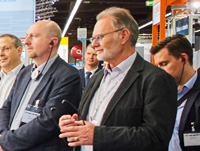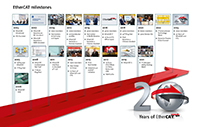
Comunicado
The EtherCAT Technology Group (ETG) is 20 years old: the association was launched with 33 founding members at the SPS/IPC/Drives exhibition in Nuremberg in November 2003. From the very beginning, the aim of the association has been to disclose and promote EtherCAT technology worldwide: everyone should be able to use and implement EtherCAT. Since the beginning, the ETG has brought together end users from different industries, machine builders, and suppliers of advanced control technology.
ETG user members come from many different industries, and this has ensured that EtherCAT is optimally prepared for a wide range of applications. With their qualified feedback, the system partners have assured that integration of the hardware and software components in all required device classes is easy. Soon, universities and research institutes came onboard and started using EtherCAT for teaching and a wide range of research projects.
The ETG quickly grew to become the world's biggest fieldbus association. After just 5 years, the 1000-member mark has already been surpassed, with members including companies, universities and organizations, but not individuals. Growth then accelerated even further: in 2014 there were 3000 members and by 2018 there were already 5000, and the association now has almost 7500 members from 74 countries and continues to grow rapidly with almost 500 new members every year.
Founded and based in Nuremberg, ETG established offices in the USA, China, Japan, and Korea as early as 2007. The Conformance Test Centers were opened in 2009. Right from the start, the ETG has supported its members with free workshops, software, and support in implementing the technology. The Plugfests are also very popular: to date, the ETG has held a total of 59 of these multi-day developer meetings to test device interoperability in Europe, Asia, and North America.
In the numerous technical working groups, ETG members continue to advance EtherCAT, always under the premise that the technology must be expanded in a backward compatible manner, but may not be changed. Therefore, there is only one version of EtherCAT, and today's devices can be used in systems from 2004 without any problems.
In 2005, Safety over EtherCAT was added to the technology. This extension is also known as FSoE (Fail Safe over EtherCAT) and meets the requirements of IEC 61508 and IEC 61784, integrates safety-critical communication into the system, and is suitable for applications up to SIL 3. Safety over EtherCAT is also stable: as the only Industrial Ethernet safety protocol, it did not have to be changed in order to meet the increased requirements of the more stringent standards.
EtherCAT P (EtherCAT + Power) is an extension of the EtherCAT technology for cabling that was introduced in 2016. The P stands for Power and enables the four-wire standard Ethernet cable to be used not only for data, but also for two electrically isolated, individually switchable 24 V/3 A supplies. Several EtherCAT devices can be cascaded. This means that only one cable is required to connect and supply power to field devices.
With EtherCAT G, the next fully backward compatible technology expansion is in the starting blocks. EtherCAT G extends the application spectrum of EtherCAT to devices with particularly high bandwidth requirements without replacing the robust and proven 100 Mbit/s technology.
Opening the technology not only led to association specifications but also to numerous national and international standards. EtherCAT and Safety over EtherCAT are international IEC standards, national standards in China and Korea, SEMI standards for the semiconductor industry, and the ETG is an official standardization partner of IEC and IEEE.
The association promotes the technology not only by actively supporting the many device manufacturers, but also through seminars and exhibition booths around the world. To date, the ETG has held 175 roadshows in more than 50 countries and has presented the technology at well over 200 exhibition booths.
In 2023, to mark the 20th anniversary of the technology, the EtherCAT Technology Group published node figures for the first time. Not counting modular devices such as bus terminals, almost 60 million EtherCAT chips were sold by the end of 2022, with multi-protocol chips only counted according to the EtherCAT market share. The manufacturers of EtherCAT devices, who number over 3,500, are therefore likely to have ensured that EtherCAT has become the most widely used Industrial Ethernet technology in time for the big anniversary.
Título de imagen
A timeline of 20 years of ETG

Contacto de prensa
Si desea más información de relaciones públicas póngase en contacto con Email: press@ethercat.org
Archivo de prensa
Archivo de prensa 2018
Archivo de prensa 2017
Archivo de prensa 2016
Archivo de prensa 2015
Archivo de prensa 2014
Archivo de prensa 2003-2013

